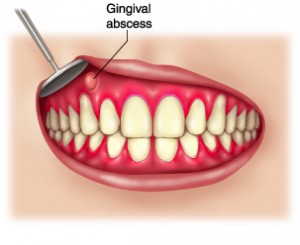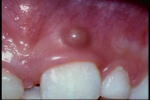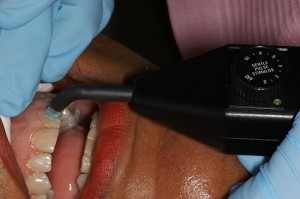Having sore gums or a gumboil? Does your tooth hurt upon biting or feels loose? Notice pus oozing out from the gums? You could be suffering from a gum abscess.
What is a gum abscess?
A gum abscess (known as periodontal abscess among dental professionals) is a localized area of inflammation in which formation of pus has taken place in the tissues supporting the teeth, also called periodontal tissues.
What are the predisposing factors for gum abscess formation?
- Obstruction of the opening to a deep gum pocket
- Gum injury with a foreign body, for example fishbone, toothpick or toothbrush bristle
- Incomplete removal of plaque and tartar beneath the gum line from deep gum pockets
- Infection produced by excessive stress on biting, for example bruxism
- Consequence of pulp disease through the root tip or lateral root canals
- Perforation of the walls on the sides of the tooth during root canal treatment
- Altered host immune response, for example diabetes
Why does gum abscess occur?
Bacterial invasion and multiplication occurs within the gum pockets due to any of the predisposing factors listed above.
What are the signs and symptoms of gum abscess?
- Pain on biting or deep throbbing pain
- Tooth appears to be elevated in the socket
- May be loose
- Overlying gum becomes red, swollen and painful to touch
- Pus formation with tracking through the bone to form a red, shiny, painful swelling over the jaw bone
- Pus may discharge through the gum pocket
- Pus may spread into soft tissues to produce cellulitis of the face
- Elevated temperature with enlarging lymph nodes around area of concern
What is the difference between a gum abscess and a tooth abscess?
The same features of a gum abscess may be produced by a periapical or tooth abscess. Both abscesses need to be differentiated as treatment for both differ from each other. The following criteria can be used to tell the difference between both:
- Position of the abscess – if the abscess is at the root tip, it is more likely to be of pulp origin which causes dental abscess
- Gum disease with pocketing and bone loss – gum abscess
- Filled or decayed tooth with history of sensitivity to hot or cold – tooth abscess
- Dead tooth – may be either pulp, gum or combined
- Normal healthy tooth – gum abscess
Investigations of a gum abscess
- Radiographs or x-rays are taken to identify the source of infection, whether it originated from the tooth or the gums
- Pulp vitality test is done to assess the vitality of the tooth
- Microbial test is conducted using the pus sample for culture and sensitivity testing to identify the microorganisms involved
- Other tests may be conducted, for example blood sugar examination
How to treat a gum abscess
The main abscess treatment is to provide relief of pain and to control the spread of infection. Drainage can be established through the gum pocket or by incision of the abscess in mouth.
Drainage through the gum pocket
- The area is anesthetized topically or local anesthesia is injected around the periphery of the abscess away from the inflamed area.
- A probe is carefully introduced into the pocket to distend the pocket wall for drainage.
- The pus is eased out of the pocket, and followed by saline irrigation.
- A curette is gently inserted into the pocket to further drain and curette any granulation tissue.
Drainage through incision
- A surgical blade is used to make a horizontal incision through the most fluctuant part of the swelling.
- A curette or periodontal elevator is used to gently elevate the tissues to allow drainage.
- After drainage stops, the area is irrigated with saline.
- Sutures are usually not required.
- You are then instructed to rinse often with a solution of one tablespoon spoon in a glass of warm water.
- Antibiotics may be prescribed if necessary. Pain killers are prescribed for pain.
- Follow up evolution is done the next day.
Subsequent treatment
- Scaling beneath the gum line (subgingival) and root planing
- Periodontal flap surgery to treat associated bone defects as abscess on gum may perforate the jaw bone.
- Extraction of the tooth involved if poor prognosis is suspected.
Antibiotics are needed if there are signs of spread of infection such as:
- Swelling of the face
- Rise in body temperature
- Inflammation of the lymph nodes surrounding the area concerned
When to contact your dentist
Contact your dentist when you show the following symptoms:
- Redness and swelling or pain on the gums
- Pus discharge from the gums or gum pocket
- Tooth feels painful on biting
- Tooth feels like its floating in its socket



